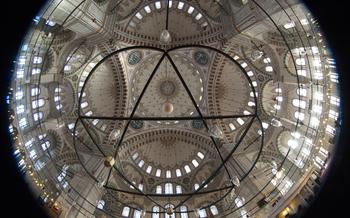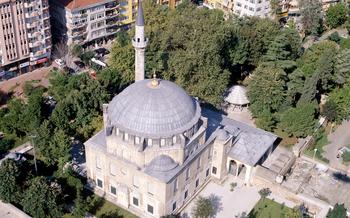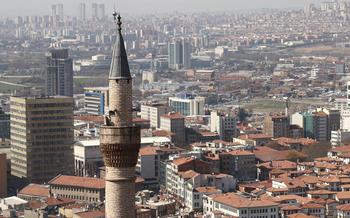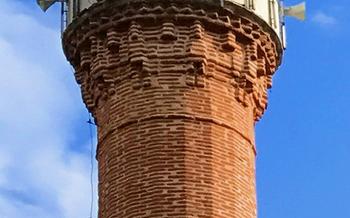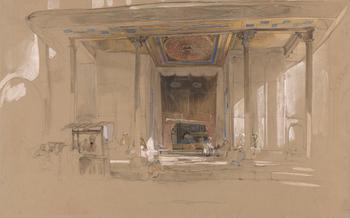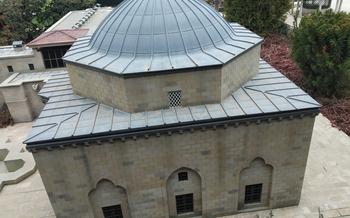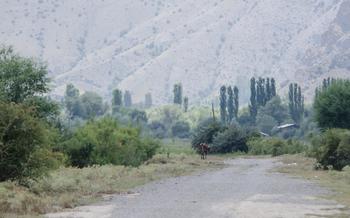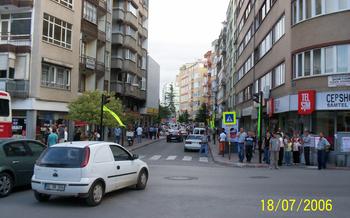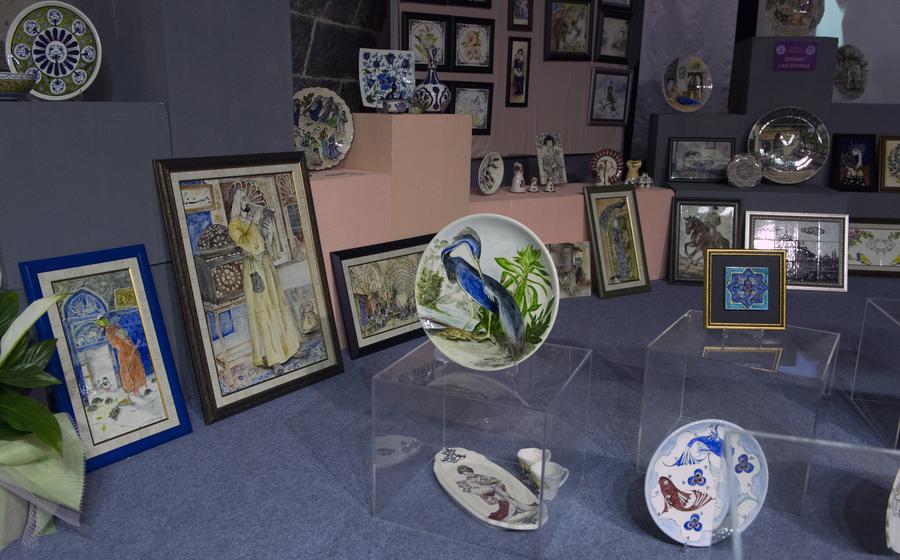
Kurşunlu Külliyesi
- Kurşunlu Külliyesi: A Historical Gem in Eskişehir
- Exploring the Mosque: A Journey Through Time
- Unveiling the Imaret: A Place of Charity and Learning
- Discover the Mausoleum: A Tribute to Piety
- Exploring the Complex's Courtyard: A Place of Serenity
- Unveiling the History of Kurşunlu Külliyesi: A Tale of Piety and Generosity
- Tips for Visiting Kurşunlu Külliyesi: A Memorable Experience
- Uncovering the Architectural Masterpieces: A Blend of Ottoman and Seljuk Styles
- Appreciating the Fine Details: A Showcase of Exquisite Craftsmanship
- Experiencing the Local Culture: A Warm Welcome in Eskişehir
- Exploring the Neighborhood: Discover Hidden Gems
- Kurşunlu Külliyesi as a Symbol of Tolerance: A Place of Harmony
- Kurşunlu Külliyesi in Literature and Art: A Source of Inspiration
- Insider Tip: Unveiling a Hidden Gem
Kurşunlu Külliyesi: A Historical Gem in Eskişehir
Nestled in the heart of Eskişehir, Turkey, lies the magnificent Kurşunlu Külliyesi, a historical complex that stands as a testament to the city's rich architectural heritage. Built in the 15th century during the reign of the Ottoman Sultan Mehmed I, the külliye (Islamic religious and social complex) encompasses a mosque, an imaret (soup kitchen), a bathhouse, a mausoleum, and a courtyard, each boasting unique architectural features and historical significance.
Located in the Odunpazarı district, surrounded by charming Ottoman-era houses and narrow cobblestone streets, the Kurşunlu Külliyesi seamlessly blends with the surrounding cityscape. Its strategic position reflects the importance placed on religious and social welfare during the Ottoman period, as it served as a hub for both spiritual and communal activities.
The architectural significance of the Kurşunlu Külliyesi lies in its intricate blend of Ottoman and Seljuk architectural styles, showcasing the evolution and synthesis of these two influential traditions. The complex's monumental structures, adorned with exquisite tilework, intricate carvings, and elegant calligraphy, embody the artistic and cultural achievements of the era.
Exploring the Mosque: A Journey Through Time
The mosque at Kurşunlu Külliyesi stands as a testament to the architectural brilliance and religious devotion of its time. Its unique features set it apart from other mosques in the region, making it a must-visit for those interested in Islamic architecture and history.
The most striking feature of the mosque is its octagonal shape, a design that is rarely seen in Ottoman architecture. This unique shape creates a sense of spaciousness and grandeur, allowing for a larger number of worshipers to gather within its walls.
The interior of the mosque is adorned with intricate tilework and colorful mosaics, depicting verses from the Quran, geometric patterns, and floral motifs. The mihrab, the niche indicating the direction of Mecca, is particularly impressive, featuring intricate carvings and delicate calligraphy.
The domed ceiling of the mosque is adorned with beautiful frescoes, depicting scenes from the life of the Prophet Muhammad and other religious figures. These frescoes provide a glimpse into the artistic traditions of the Ottoman period and add to the spiritual atmosphere of the mosque.
Kurşunlu Mosque holds great historical significance as well. It was built during a time of great religious fervor and served as a center for Islamic learning and worship. Over the centuries, it has undergone several renovations and additions, reflecting the changing needs and tastes of the community.
Today, the mosque continues to function as a place of worship for the local Muslim community. Visitors are welcome to enter the mosque outside of prayer times to admire its architectural beauty and learn more about its history.
Unveiling the Imaret: A Place of Charity and Learning
Amidst the splendor of Kurşunlu Külliyesi, the imaret stands as a testament to the complex's dedication to charitable deeds and the pursuit of knowledge. This remarkable structure was conceived as a place where the needy could find sustenance and where students could quench their thirst for learning.
The imaret's architectural design reflects its dual purpose. Its spacious interior is divided into two main sections: a dining hall and a madrasah (Islamic school). The dining hall, with its long rows of tables and benches, evokes a sense of communal dining and generosity. Here, the hungry were provided with nourishing meals, ensuring that the less fortunate were not forgotten amidst the opulence of the külliye.
Adjacent to the dining hall is the madrasah, a sanctuary of learning where students gathered to study Islamic sciences, literature, and other subjects. The classrooms, with their intricate tilework and serene atmosphere, provided a conducive environment for the pursuit of knowledge. The imaret's dual function as a soup kitchen and a madrasah highlights the complex's commitment to both physical and intellectual nourishment.
Beyond its practical functions, the imaret holds significant cultural and educational value. It represents the importance of charity and education in Islamic society, where providing for the needy and fostering knowledge were considered sacred duties. The imaret's enduring legacy as a center of learning and compassion continues to inspire and educate visitors to this day, reminding them of the enduring power of generosity and the transformative impact of knowledge.
Discover the Mausoleum: A Tribute to Piety
Within the serene confines of the Kurşunlu Külliyesi, the mausoleum stands as a testament to piety and devotion. This sacred structure serves as the final resting place for several prominent historical figures, each leaving an indelible mark on the city's rich tapestry.
The mausoleum's architectural design is a testament to the enduring legacy of Ottoman craftsmanship. Its octagonal shape, adorned with intricate tilework and decorative inscriptions, exudes an aura of grandeur and reverence. Inside, visitors are greeted by a tranquil ambiance, where the soft echoes of prayers mingle with the gentle rustling of prayer beads.
Among those interred within the mausoleum are the founder of the complex, Kurşunlu Mehmet Pasha, and his wife. Their tombs, adorned with elaborate carvings and calligraphy, stand as symbols of their deep faith and devotion. Other notable figures buried here include scholars, poets, and religious leaders, each contributing to the cultural and spiritual heritage of Eskişehir.
The mausoleum is not merely a place of remembrance but also a symbol of the enduring power of faith. Its presence within the Kurşunlu Külliyesi serves as a reminder of the deep spiritual roots that have shaped Eskişehir's identity throughout the centuries.
Exploring the Complex's Courtyard: A Place of Serenity
The courtyard of Kurşunlu Külliyesi, a tranquil haven amidst the bustling city, invites visitors to immerse themselves in its serene atmosphere. As you step into the courtyard, you are greeted by a mesmerizing sight—a verdant expanse adorned with lush gardens, sparkling water features, and the gentle murmur of flowing water. The courtyard's layout is a testament to the thoughtful planning and attention to detail that went into the design of the complex.
Paths paved with intricate stonework meander through the courtyard, leading visitors to various sections of the külliye. These paths are lined with cypress trees, their towering presence adding an air of grandeur and tranquility to the space. The central fountain, a masterpiece of Ottoman engineering, is a focal point of the courtyard. Its cascading waters create a soothing symphony that fills the air, adding to the courtyard's serene ambiance.
The courtyard also features several seating areas, allowing visitors to pause and soak in the tranquil atmosphere. These seating areas are strategically placed under the shade of trees, offering respite from the summer sun and inviting visitors to linger and contemplate the beauty of their surroundings. The courtyard of Kurşunlu Külliyesi is not just a physical space; it is a sanctuary of peace and tranquility, offering a respite from the hustle and bustle of everyday life.
Unveiling the History of Kurşunlu Külliyesi: A Tale of Piety and Generosity
The construction of Kurşunlu Külliyesi is attributed to the pious and generous grand vizier, Çandarlı Halil Pasha, who served during the reign of Sultan Murad II. Pasha was renowned for his devotion to Islam and his patronage of numerous charitable and educational institutions throughout the Ottoman Empire.
Historical accounts suggest that Çandarlı Halil Pasha was deeply moved by the plight of the poor and underprivileged in Eskişehir. Determined to alleviate their suffering and provide for their well-being, he commissioned the construction of Kurşunlu Külliyesi as a comprehensive social and religious complex. The külliye was envisioned as a place where the community could gather for worship, education, and charitable assistance.
The construction of the külliye began in the early 15th century and was completed during the reign of Sultan Mehmed II, known as Mehmed the Conqueror. The complex served as a testament to Pasha's unwavering faith and his commitment to improving the lives of those in need.
Tips for Visiting Kurşunlu Külliyesi: A Memorable Experience
To make the most of your visit to Kurşunlu Külliyesi, consider the following tips:
-
Best time to visit: Aim for early mornings or late afternoons to avoid crowds and enjoy a peaceful ambiance. The complex is particularly stunning during sunset, when the warm hues of the setting sun cast a golden glow on the structures.
-
Dress code: As a sign of respect for the religious significance of the complex, dress modestly. Avoid shorts, tank tops, or revealing clothing. Head coverings are not required but are appreciated as a sign of cultural sensitivity.
-
Photography guidelines: Photography is allowed within the complex, but avoid using flash or tripods inside the mosque. Be mindful of other visitors and avoid disturbing their prayers or contemplation.
Uncovering the Architectural Masterpieces: A Blend of Ottoman and Seljuk Styles
Kurşunlu Külliyesi stands as a testament to the architectural prowess of the Ottoman and Seljuk empires. The complex seamlessly blends the distinctive features of both styles, showcasing a harmonious coexistence of two great civilizations. The Ottoman influence is evident in the grand domes, intricate tilework, and elegant minarets, while the Seljuk elements manifest in the pointed arches, geometric patterns, and sturdy stonework. This unique fusion creates a visually stunning ensemble that reflects the cultural and historical richness of Turkey.
The architects of Kurşunlu Külliyesi skillfully integrated these different styles, resulting in a cohesive and aesthetically pleasing masterpiece. The pointed arches of the Seljuk period lend a sense of strength and stability to the structure, while the delicate tilework and calligraphy of the Ottomans add a touch of refinement and elegance. Together, these elements create a harmonious balance that is both visually appealing and historically significant.
Beyond its architectural significance, the blending of Ottoman and Seljuk styles in Kurşunlu Külliyesi symbolizes the cultural and political unity that existed between these two great empires. It serves as a reminder of the rich tapestry of civilizations that have shaped Turkey's history and continue to contribute to its vibrant cultural heritage.
Appreciating the Fine Details: A Showcase of Exquisite Craftsmanship
The Kurşunlu Külliyesi is a testament to the extraordinary craftsmanship and attention to detail that characterized Ottoman and Seljuk architecture. Visitors are captivated by the intricate tilework and colorful mosaics that adorn the walls, creating breathtaking patterns and designs. The tiles, painstakingly hand-painted and arranged, depict a variety of motifs, from geometric patterns to floral designs, adding a vibrant touch to the complex's interior.
Equally impressive are the detailed carvings and stonework that embellish the buildings. From intricate vegetal motifs to delicate geometric designs, the carvings showcase the skill and artistry of the craftsmen who created them. The intricate stonework, often featuring verses from the Quran or decorative patterns, adds a touch of elegance and sophistication to the complex's overall aesthetic.
The Kurşunlu Külliyesi is also renowned for its beautiful calligraphy and decorative inscriptions. The walls are adorned with verses from the Quran, written in elegant Arabic calligraphy, creating a sense of spirituality and reverence. The inscriptions, often accompanied by intricate floral or geometric designs, add a touch of artistic flair to the complex's interior.
Experiencing the Local Culture: A Warm Welcome in Eskişehir
Eskişehir, the city that embraces Kurşunlu Külliyesi, exudes a welcoming ambiance that instantly captivates visitors. The locals of Eskişehir are renowned for their warm hospitality and genuine friendliness, creating an environment where travelers feel at home. Engage in conversations with the locals to discover their rich stories, traditions, and customs. Immerse yourself in the vibrant local culture by attending traditional events, savoring the delectable cuisine, and visiting bustling markets. Eskişehir offers a unique opportunity to connect with the Turkish way of life and forge lasting friendships with the welcoming people of this charming city.
Exploring the Neighborhood: Discover Hidden Gems
While visiting the Kurşunlu Külliyesi, take some time to explore the surrounding neighborhood and uncover its hidden gems. Just a short walk away, you'll find the vibrant Eskişehir Bazaar, a bustling marketplace where you can immerse yourself in the local culture and indulge in traditional Turkish delights. Browse the colorful stalls selling fresh produce, handmade crafts, and souvenirs, or savor the aromas of freshly baked goods and traditional Turkish cuisine.
Eskişehir is also home to several other historical and cultural attractions. Visit the Eskişehir Archaeological Museum to learn about the region's rich history, or admire the stunning architecture of the Odunpazarı district, a well-preserved Ottoman-era neighborhood with cobblestone streets and charming wooden houses.
For those seeking a unique experience, venture to the Eskişehir Modern Glass Art Museum, which showcases a diverse collection of contemporary glass art from Turkey and around the world. Here, you'll find intricate sculptures, colorful mosaics, and innovative glass installations that will captivate your senses.
Kurşunlu Külliyesi as a Symbol of Tolerance: A Place of Harmony
Kurşunlu Külliyesi stands as a testament to the harmonious coexistence of different religions throughout history. Eskişehir has long been home to a diverse population, including Muslims, Christians, and Jews. The city's history is marked by periods of peaceful coexistence and cooperation among these communities.
The külliye itself embodies this spirit of tolerance. The complex includes a mosque, an imaret, a bathhouse, and a mausoleum, all of which were built during the Ottoman period. Despite their different functions, these structures share a common architectural style and design, reflecting the shared values and beliefs of the city's diverse population.
Kurşunlu Külliyesi serves as a reminder of the importance of religious tolerance and understanding. In a world often divided by religious conflicts, the külliye stands as a symbol of the possibility of peaceful coexistence among people of different faiths.
Kurşunlu Külliyesi in Literature and Art: A Source of Inspiration
Kurşunlu Külliye has served as a muse for various artistic expressions, finding its way into literature, poetry, and art. Turkish author Ahmet Ümit, known for his historical novels, featured the külliye in his book "Sultan's Seal," weaving it into the narrative as a place of mystery and intrigue. The intricate architecture and historical significance of the complex have also captured the attention of poets, who have penned verses that evoke its beauty and grandeur.
In the realm of visual arts, painters and photographers have been drawn to Kurşunlu Külliye's captivating aesthetics. Artists have immortalized the külliye's stunning facades, serene courtyard, and intricate details in their paintings and photographs, showcasing its architectural brilliance and the passage of time.
The cultural significance of Kurşunlu Külliye extends beyond its physical presence. It serves as a reminder of the rich historical and cultural heritage of Eskişehir and Turkey as a whole. Through literature and art, the külliye continues to inspire and engage audiences, fostering a deeper appreciation for its history, architecture, and cultural significance.
Insider Tip: Unveiling a Hidden Gem
Amidst the grandeur of Kurşunlu Külliyesi, a hidden gem awaits discovery. Tucked away in a serene corner of the courtyard, visitors can uncover the enchanting "Gizli Bahçe" (Secret Garden). This secluded haven, once a private retreat for religious scholars and students, offers a tranquil escape from the bustling city.
Lost in time, the Secret Garden exudes an air of tranquility, with lush greenery, fragrant flowers, and the gentle murmur of a hidden fountain. Visitors can relax on the stone benches, surrounded by the beauty of nature, and immerse themselves in the serene atmosphere that permeates this hidden gem.
Accessible through a discreet entrance, the Secret Garden offers a unique perspective on the history and culture of Kurşunlu Külliyesi. It serves as a testament to the complex's enduring legacy as a place of contemplation, learning, and spiritual rejuvenation.

